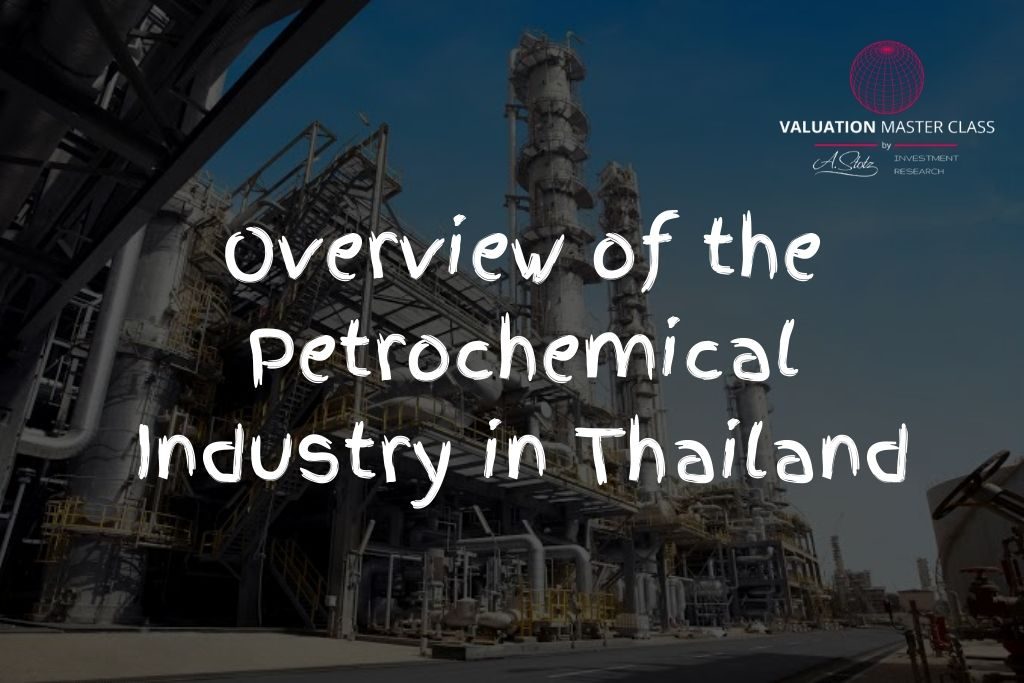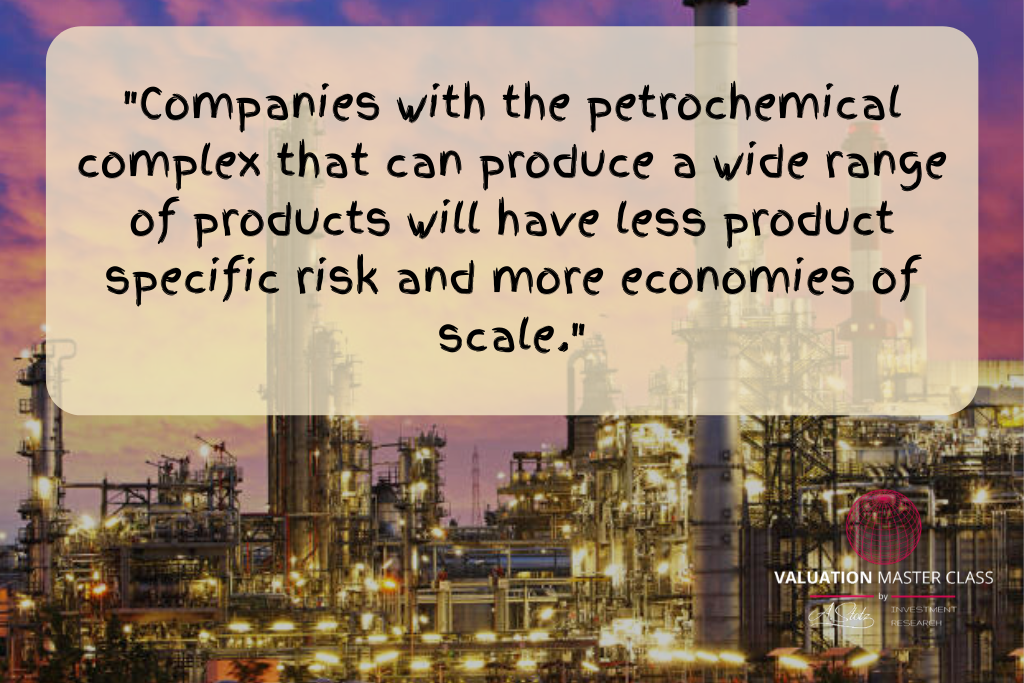Overview of the Petrochemical Industry in Thailand

This is a Valuation Master Class student essay by Tossapon Rodyim from June 9, 2019. Tossapon wrote this essay in Module 3 and has since completed all five modules of the Valuation Master Class.
Petrochemical companies use products from crude oil and natural gas to produce petrochemical products to be used as raw materials in many industries such as packaging, auto, construction, and consumer products. The end products range from plastic bottles, clothes, auto parts and many more. There are many factors that affect the prices of petrochemical products, feedstock and spreads between them because they will affect the profitability of the companies. There are 5 major petrochemical companies in Thailand with different product mixes. Investors need to understand their business before investing in them. Also, petrochemical is a cyclical business in which each cycle takes around 7-9 years.
Petrochemical companies convert products from crude oil and natural gas to various kinds of petrochemical products
The petrochemical industry is a large-scale business with complex production processes and high capital expenditure. Building a petrochemical complex requires high technology and accommodative utilities. Also, the business has a long payback period. Many large petroleum plants are forward integration business from oil refinery or oil exploration business. For example, PTTEP explores the sources of crude oil and natural gas then provides those as raw materials for PTTGC to convert them to petrochemical products which are raw materials for many industries.
The petrochemical production process has 4 stages
- Feedstock: Feedstocks are raw materials for petrochemical products obtained by separating substances (cracking process) in crude oil and natural gas in the oil refinery business. Feedstocks are as follows
-
- Natural gas from underground and under the sea which separated to ethane, propane LPG and NGL.
- Condensate obtained by cracking natural gas
- Naphtha obtained by cracking crude oil
- Sugar cane, cassava, and palm oil are raw materials for green chemicals such as bioplastic and biodiesel
- Upstream petrochemical industry: Upstream petrochemicals are used as raw materials or mix with other substances to produce next stage petrochemicals products. Upstream petrochemicals can be divided into two categories by their molecular structure, olefins, and aromatics.
-
- Olefins products include Methane, Ethylene, Propylene and Mixed-C4 gas.
- Aromatics products include Benzene, Toluene, and Xylene.
- Intermediate petrochemicals industry: The products in this stage produces from upstream products. Intermediate products include Vinyl Chloride and Styrene
- Downstream petrochemicals industry: Downstream products are produced from upstream and intermediate products. The products can be divided into 4 categories.
-
- Plastic resins: The important products are Polyethylene, Polypropylene, PVC, ABS, PET, and Polystyrene. They are used as raw materials in packaging, auto, construction materials, and consumer products industries.
- Synthetic fibers: The products are Polyester, Polyamide fiber, and Nylon. They are raw materials many industries such as packaging and clothing.
- Synthetic rubber: Their usage is mainly raw materials in auto parts, car tires, and consumer products. Examples of products are SBR and BR.
- Synthetic coating and adhesive materials: The important products are Polycarbonate and Polyvinyl acetate. They are used in various industries such as construction materials.
The main cost of petrochemical business is the cost of raw materials which accounted for 60-70% of the total cost. Cost of utilities and logistics accounted for 15-20% and fix cost 15-20%. The business is a cost leadership business. The company that can achieve economies of scale and can produce products with less cost compared to competitors will have a competitive advantage. Petrochemical companies’ cost depends on the feedstock used as raw material, technology and logistics. Also, companies with the petrochemical complex that can produce a wide range of products will have less product specific risk and more economies of scale.
Factors that affect the profitability of petrochemical companies in Thailand are the price of petrochemical products and feedstock, product spread, GIM, capacity utilization and exports to China
Before investing in petrochemical companies, investors need to look at many indicators and factors that are affecting the companies. The factors are as follows:
- Price of petrochemical products: Price of petrochemical products depend on global demand and supply of the products. Demand for the products will increase if economic activity and the demand for their end products in many industries such as packaging, auto, construction, etc.) increase. For example, demand for PET will rise if demand for plastic bottle increase. The supply of the products is depending on the number of petrochemical plants operating around the world. More plants mean more supply for the products. There may be cases where some of the plants need to undergo maintenance which will reduce the supply momentarily.
- Feedstock: change in oil price and natural gas will affect the cost of raw materials for the companies. The companies need to book stock gain and loss when feedstock price go up and down which affect the profitability of the companies. Also, the price of feedstock will affect product spread, the profitability indicator of the business.
- Product spread: It is the difference between the price of raw material and the price of a certain petrochemical product such as HDPE spread over Naphtha, PE spread, PTA spread, etc. They’re the profit margin of the products. The spread widens if the price of the product is rising faster or falling lower than the price of its feedstock.
- Gross Integrate Margin (GIM): It is the difference between the value of all petrochemical products that the company produces and the total cost of production. GIM depends on the spreads of each product, raw material, capacity utilization, cost of production, etc.
- Capacity utilization: The more is better for the companies. The capacity may decrease when there is maintenance or some technical problems at the plants. The investor can expect that utilization will decrease if there is scheduled maintenance for plants in any particular period.
- Export to China: Another factor that affects the profitability of Thai petrochemical companies is petrochemical export to China. Around half of the downstream product output in Thailand is exported to overseas. Petrochemical products export to china accounts for around 30% of all petrochemical export. Therefore, if there is an economic slowdown in China, the country may import fewer products from Thailand which hurts the profitability of the companies in Thailand.
These are the 5 major petrochemical companies in Thailand, which are PTT, IRPC, TOP, IVL, and SCC
Most petrochemical products in Thailand are commodity-grade, therefore the companies are focusing on cost leadership strategy to cut costs and invest in other companies to backward and forward integration of their business to increase profitability. The products are mostly olefins products that used natural gas as raw material that can be found in the Gulf of Thailand. Around half of downstream products are used domestically and the other half is exported. The major petrochemical companies in Thailand are as follows.
- PTTGC is a diversified and comprehensive petrochemical company. PTTGC’s business range from oil refinery to production of petrochemical upstream, intermediate and downstream products in both aromatics and olefins products. 55% of the EBITDA margin is from olefins products such as HDPE, LDPE, and LLDPE. Therefore, the spreads of HDPE, LDPE, and LLDPE are very important profitability indicator of the company
- IRPC is a comprehensive petrochemical company whose main business is an oil refinery. However, profit from the petrochemical business is accounted for 30% of net profit. The revenue from the petrochemical business is mostly from olefins products
- TOP operates oil refineries and petrochemical plants. The petrochemical products output is Aromatics products such as Paraxylene, Benzene, and Toluene. Profit from the petrochemical business is accounted for 26% of net profit.
- IVL is a petrochemical company whose main products are PET and synthetic fibers.
- SCC has many businesses which include cement, construction materials, packaging, and petrochemical. The company produces various olefins products such as HDPE, MDPE, LLDPE, LDPE, PP, and PVC. Some of the products are sold to other companies and some are used in the company’s construction materials and packaging business.
Petrochemical is a cyclical industry with long lead-time for business expansion
Petrochemical business is a cyclical business. Historically, the cycle of the business is around 7-9 years. The cause of cyclicality is that when the demand for petrochemical products and plant capacity reaches its peak, the price and profit margin of the products are high which indicates the peak of the business cycle and it will attract investors to invest in building new plants to expand capacity. However, the construction of petrochemical plants takes 3-5 years. When the plants are completed, the supply of petrochemical products will rise but the demand may not be as high as supply which, in turn, lower product prices and profit margin of the business indicating the bottom of the cycle. Therefore, petrochemical plants are built to have a high capacity to benefit economies of scale and to support the demand of the products when they are at their peaks. Also, investment amount and timing need to be in line with the demand forecast of the petrochemical products.
To conclude, petrochemical companies use 4 stages to convert crude oil and natural gas to petrochemical products to be used in other industries. Investors should invest in the companies when product spreads are widening which caused by higher economic activity causing demand for petrochemical products rising faster than its feedstock. Also, Thailand exports a lot of petrochemical products to China. Investors need to consider the China economy and its policy to import and usage of the products. Of all the 5 major petrochemical companies in Thailand that are listed in SET. PTTGC, IRPC, and SCC mainly make profits from olefins products while TOP and IVL specialize in Aromatics. Moreover, the business is cyclical with 7-9 years per cycle. The plan to expand the business needs to be planned carefully as it takes 3-5 years to build new plants and the plan needs to be supported by data of demand and supply of the products.

